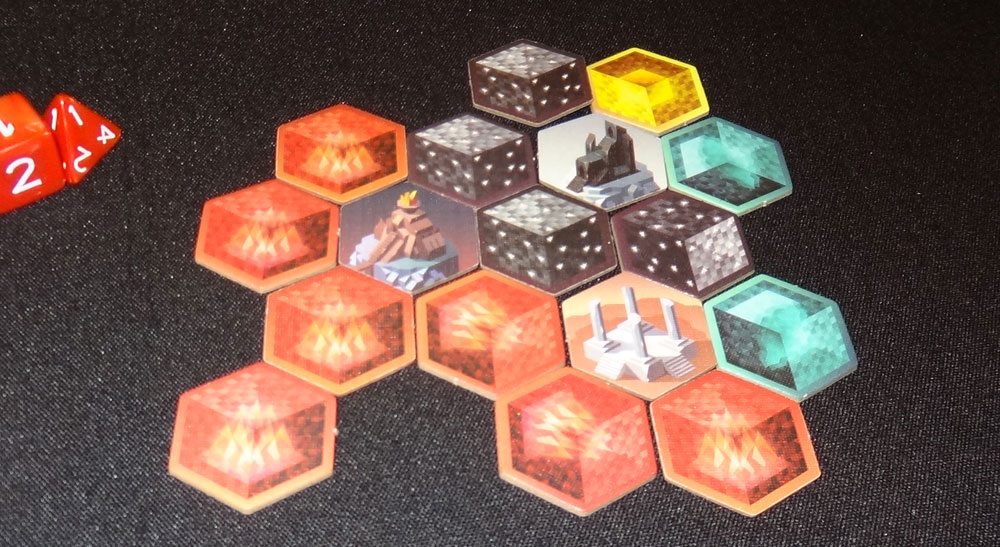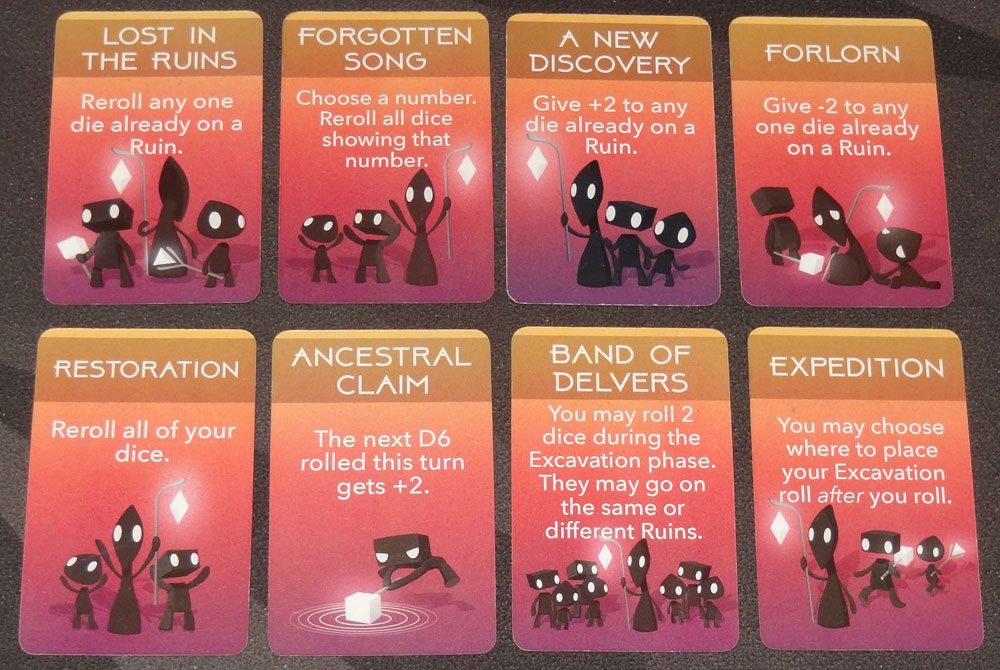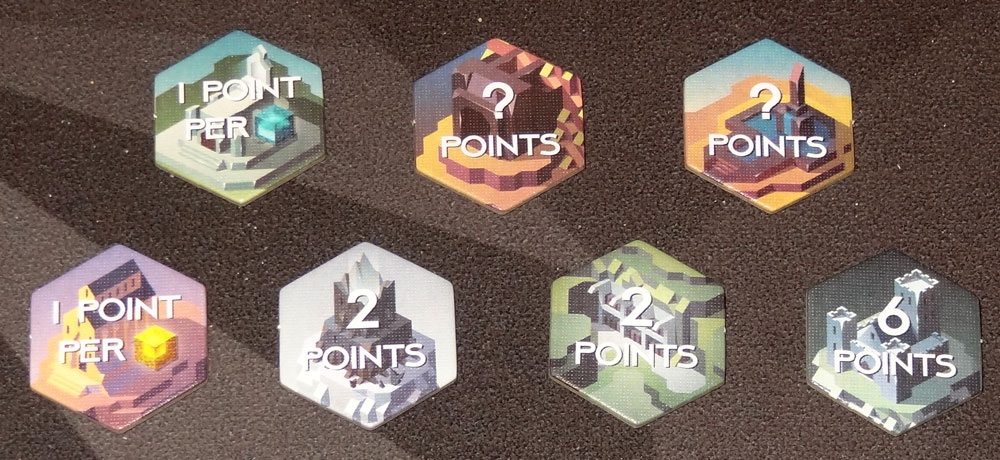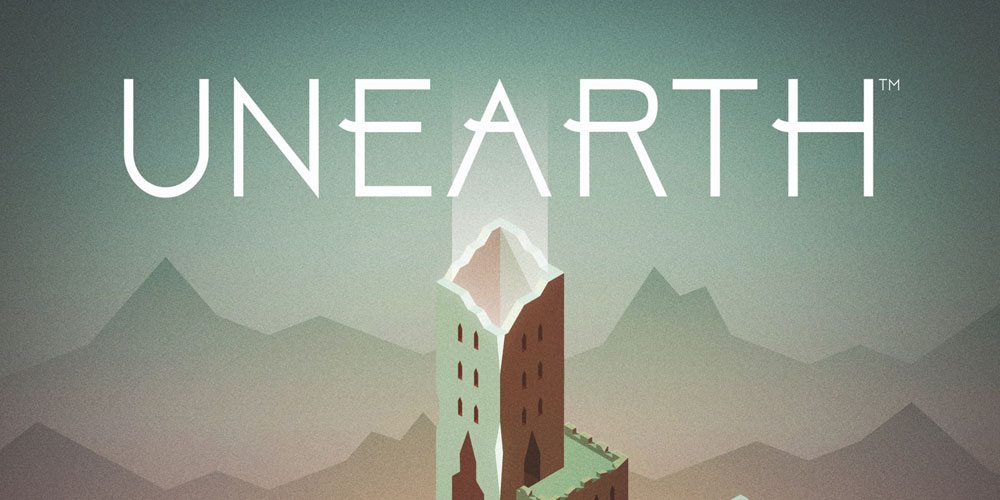Your civilization, once a marvel of the world, has long been in ruins. It’s time to Unearth the past and rebuild!
What Is Unearth?
Unearth is a game from Brotherwise Games for 2 to 4 players, ages 8 and up, and takes about 30–60 minutes to play. The retail price is $34.95, and it’s available in stores and from online retailers like Amazon. I think the age rating is accurate: the gameplay isn’t too difficult to pick up, and there isn’t anything thematically inappropriate for kids.

Unearth Components
- 25 Ruins cards
- 5 End of Age cards
- 38 Delver cards
- 17 Wonder cards (15 named wonders, 1 Greater Wonder, 1 Lesser Wonder)
- 31 Wonder tokens
- 60 Stone tokens (15 each in 4 colors)
- 20 dice (5 dice in each of 4 colors)
- 4 player aids
- Cloth storage bag
The tokens are all small hex-shaped pieces, which punch out easily. The “stones” are made to look like little (isometric) cubes, and the wonders are all small illustrations of various locations and buildings. Each player gets one set of dice, which consists of one d4, three d6, and one d8. The dice are fairly standard, in four different player colors. The ruins and end of age cards are tarot-sized cards, the Wonder cards are standard-sized, and the delver cards are mini cards, and all the cards are fine quality.

Jesse Riggle’s artwork is of isometric ruins, and a lot of people have noted the comparison to mobile game Monument Valley. I would note that, although Monument Valley does indeed use isometric buildings, a key component is the optical illusions, which are not present in Unearth. There is a similarity between the typefaces used for the titles as well, which is unfortunate. It looks nice, but the resemblance can feel problematic. Personally, I do like the artwork and I don’t think Monument Valley has a monopoly on isometric graphics—but I do think Unearth could have done more to set itself apart if they wanted to avoid criticism. One note about the ruins is that the purple ruins (far left) sometimes gets confused with the white ruins (far right), because they both have elements of purple in them—the key is to look at the background colors.

The game has a custom plastic insert that I’m not too fond of. The wells are much deeper than necessary, though apparently that’s to make room for sleeved cards. The biggest issue, though, is that the well had a recessed area in the center for the cardboard sheets that you punch out—but that means that once you discard the cardboard, there’s a gap between the top of the insert and the lid of the box, so when your friend picks up the box to look at the back, everything falls out and gets mixed up. But since that cardboard space was recessed, you can’t even put the old cardboard underneath to raise the insert—the lip prevents that. I suppose the only solution would have been to put the cardboard sheets back into the recessed area, where they would hold things in place, but then you have to remove them every time you open the box.

How to Play Unearth
You can download a PDF of the rulebook here.
The Goal
The goal of the game is to score the most points by gathering ruins and building wonders.

Setup
Put all of the stone tokens into the bag. Shuffle the delver cards and deal 2 to each player, and shuffle the ruins deck and deal one to each player. All of these cards are hidden from other players. Each player gets a set of dice.
Remove the top 5 cards from the ruins deck and return them to the box without looking at them. Shuffle the end of age cards and place one random one at the bottom of the ruins deck, returning the rest to the box. Then reveal the top five ruins in a row on the table. Draw stones from the bag and place them on the ruins cards, as indicated by the number in the bottom right corner of the card. (For a 2-player game, remove 10 ruins from the deck, and reveal 4 ruins on the table.)
Set out the Greater Wonder and Lesser Wonder cards and stack the corresponding wonder tokens (shuffled face-down) onto the cards. Then shuffle the wonder deck and draw 2 more than the number of players, setting them face-up and placing their corresponding tokens on them. Return the rest of the wonder cards and tokens to the box. Roll for starting player, and then play continues clockwise.

Turn Order
On your turn, you may Delve, and then you must Excavate:
- Delve: Play any number of delver cards from your hand. Each card is resolved immediately after it is played and then discarded.
- Excavation: Choose any of the face-up ruins cards; roll one die from your pool and place it on that ruins card. (If you have no more dice in your pool, take any of your dice from any ruin.)
Taking Stones
If you roll a 1, 2, or 3 at any time, you immediately take a stone of your choice from the ruin that die is placed on. If there are none left on the card, you draw a random stone from the bag. (Note that whenever a die is re-rolled due to a card, the owner of the die is the one who re-rolls it and claims the stone if applicable.)
Claiming Ruins
If at any time the total of the dice on a ruins card meets or exceeds the claim value in the top left corner, that ruin is claimed by the player with the highest single die on the card. All other players take one delver card for each die they had on the ruin, and then all dice are returned to their owners and a new ruin card is flipped face-up and stones are placed on it. If there’s a tie for the single highest die, the die with more faces wins; if it’s still a tie, go to the next-highest die from the tied players, and so on. If the tie is unbreakable, the ruin card is returned to the box and all players will draw delver cards instead.

Building Wonders
When you take a stone, you put it into a tableau in your play area, forming the stones into hexagonal rings. When you complete a ring, you may claim a wonder token to place in the center of the ring. Your rings may overlap, so that some stones are included in multiple rings. Once placed, stones may not be moved except through card effects.

- If the stones are all the same color, you claim a random Greater Wonder token.
- If the stones are not all the same color, you claim a random Lesser Wonder token.
- If you have the right number of stones to match a named wonder, you may claim it instead of a Greater or Lesser Wonder.

Each of the wonders provides bonuses of some sort. Some are worth points, but most also give you some sort of other effect.

Game End
The last card in the ruins deck is the end of age card. When it is revealed, follow the instructions on the card. Some end of age cards are ruins, and some are events. The game ends when all of the ruins on the table have been claimed.

You then reveal your hidden ruin card (the one dealt to you at the beginning of the game). You score points based on how many matching sets you have—the more you have of a color, the more points it’s worth. You also score 5 bonus points for having at least one of each color. Wonders may also provide scoring bonuses, and you score 5 bonus points if you built at least 3 wonders. Highest score wins, with ties going to the player with the most ruins of the highest value.

Why You Should Play Unearth
Brotherwise Games is well known for its smash hit Boss Monster and the subsequent expansions, which featured retro pixel art and a theme about building the best dungeon to wipe out bothersome heroes. Unearth is Brotherwise’s first non-Boss Monster game: it’s designed by Jason Harner and Matthew Ransom, and it was published without going through Kickstarter, another first for the company. Judging by the crowds at the booth at Gen Con, fans were quite willing to follow the Brothers O’Neal into these uncharted territories.
Unearth is a fun game with a few different elements at play: set collection, tile-laying (in building the stones), and a bit of luck. The theme isn’t tightly integrated with the gameplay as far as I could tell, but that’s okay. You’re digging up ruins and building things with stones—that’s pretty much all you need to know.
To score the most points, you’ll need to collect ruins, and the biggest scores come from specializing in a single color rather than trying to collect a little of everything. Of course, you’ll also want to keep your opponents from specializing in their colors. There’s a little bit of luck mitigation in the dice rolls—if you roll high, you’re more likely to claim a ruin. If you roll low, you get stones, which will help you build those wonders, which open up another strategy. The worst number, then, is 4: you don’t get a stone as a consolation prize, but you’re unlikely to beat everyone else with a 4.

There’s also a slight catch-up mechanic in that you get delver cards if you don’t win a ruin—the more dice you invested, the more cards you’ll draw. So sometimes it’s worth getting a die onto a ruin even if you don’t think you have a chance of winning it, simply because it will get you a card. A lot of the cards let you manipulate dice rolls, so that gives you a small bit of control over your fate. But, of course, where there are dice, there are outliers, and if you simply can’t get a good roll at all through the whole game, that doesn’t make for a great experience.

I like the wonder-building aspect because it gives you another goal—as you collect stones and build rings, you can decide whether you want to just take any stone to build wonders more quickly, or if you want to focus on particular colors in order to complete specific named wonders. And if you’re after a particular type of stone, that may affect which ruin you choose to roll for, and whether you use your d4, which is the most likely to award a stone. I also like the puzzle-like aspect of assembling the stones, because you have to decide which stones you want to use multiple times for the best overlap between wonders—not to mention keeping an eye on what other people are building so you know whether you need to build faster.
The tug-of-war between getting stones for wonders and getting higher dice values for ruins is tricky, even when you have delver cards to push your dice one way or the other. Generally, wonders by themselves won’t score enough points to overcome a nice set of matching ruins, but they may give you some other advantages during the game that can help you get the ruins you want or to help build other wonders.
Overall, I think Unearth is a great-looking game that’s a nice mix of luck and strategy, perhaps leaning toward the luck side. It might not satisfy a player looking for a heavy thinker game, but I think it may hit the sweet spot for fans of Boss Monster even though the theme and artwork are quite different. It’s good to see Brotherwise Games branching out, particularly after building up a solid fan base, and I’m curious to see what they unearth next.
Click here to see all our tabletop game reviews.
If you’d like to stay up-to-date with all of our tabletop gaming coverage, please copy this link and add it to your RSS reader.
Disclosure: GeekDad received a copy of this game for review purposes.






